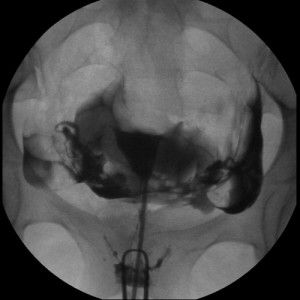Hysterosalpingogram – When is it necessary?
Hysterosalpingogram or HSG is a diagnostic X-ray test done for looking within the uterus, fallopian tubes and the adjoining areas. The test is mostly conducted in women that have had an unsuccessful time trying to conceive and facing likely infertility issues.
When hysterosalpingogram is performed, a contrasting material or dye is administered via a fine tube passing through the vaginal region and into the uterus. The dye would pass into the fallopian tubes due to it being connected to the uterus. Images are captured employing a steady shaft of X-ray or fluoroscopy with the dye passing via the uterus and in the fallopian tubes. The images could reveal issues like any form of injuries or irregular structural appearance of fallopian tubes or uterus, or any type of obstruction that is impeding egg movement via a fallopian tube to the uterus. Blockages or any form of obstruction could thwart sperm movement inside the fallopian tubes and merging with the egg which is critical to fertilization.
A hysterosalpingogram additionally might spot any problem within the uterus which could be preventing implantation of fertilized egg to the wall of the uterus.
Hysterosalpingogram – Why is it conducted?
A hysterosalpingogram is conducted for:
 Finding a blockage in fallopian tubes. The test is performed for a female who has not been able to get pregnant in spite of active efforts. An infection might be causal to acute scar formation in the fallopian tubes thus blocking them and preventing pregnancy. Sporadically, the contrasting dye employed during the test would press on the blockage in the tube, thus opening it.
Finding a blockage in fallopian tubes. The test is performed for a female who has not been able to get pregnant in spite of active efforts. An infection might be causal to acute scar formation in the fallopian tubes thus blocking them and preventing pregnancy. Sporadically, the contrasting dye employed during the test would press on the blockage in the tube, thus opening it.- Finding uterine problems like being irregularly shaped or structured, any form of injury afflicted to it, presence of polyp, fibroid, adhesion or a foreign object lodged within it. Such issues could lead to excruciating menses or recurrent miscarriages.
- The test is conducted for seeing if surgical procedure conducted for reversing a tubal ligation has been met with success.
Pre-test Preparations
Prior to hysterosalpingogram being done, it is imperative to inform one’s physician the presence of one or more of the following conditions.
- Have conceived or could be pregnant.
- Presently having a pelvic infection (PID or pelvic inflammatory disease) or sexually transmitted disease (STD like Chlamydia or gonorrhea).
- Develop allergic reaction due to exposure to iodine dye employed or other iodine-based substances. Additionally, informing the physician whether one is asthmatic, having allergic reaction to any medications or have experienced a grave allergic reaction or anaphylaxis on contact with a substance like poison due to an insect sting or consuming certain foods.
- Having any type of bleeding issues or one is on the course of blood thinners like warfarin –Coumadin or aspirin.
- Having a past case history of kidney conditions or you are diabetic, particularly in case one is taking metformin (Glucophage) for regulating it. The dye employed during the test could harm the kidney in those individuals with already weakened and poorly functioning kidney. In case a person is having a past of kidney conditions then blood analysis that involves checking for levels of blood urea nitrogen and creatinine could be performed prior to the test for checking if kidneys are functioning properly.
The hysterosalpingogram test is ideally to be conducted two to five days subsequent to conclusion of one’s menses to ensure that there is no pregnancy. Moreover, the test must be performed before a woman starts ovulating the subsequent month (exception to the case is when one is employing birth control) for avoiding use of X-rays in initial pregnancy. It would be better to carry along spare sanitary napkins for using post-test as a little seepage of the contrasting dye could happen alongside slight degree of blood loss.
Women would be required to sign on a permit form that states they are undergoing the tests after comprehending the risks associated with the test and have agreed to the test.



